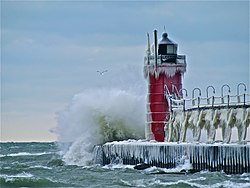South Haven, Michigan
| South Haven, Michigan | |
|---|---|
| City | |

South Haven Lighthouse, seen in winter
|
|
 Location in Van Buren County & Allegan County in the state of Michigan |
|
| Coordinates: 42°24′11″N 86°16′25″W / 42.40306°N 86.27361°W | |
| Country | United States |
| State | Michigan |
| Counties | Van Buren, Allegan |
| Government | |
| • Mayor | Robert Burr |
| Area | |
| • Total | 3.50 sq mi (9.06 km2) |
| • Land | 3.40 sq mi (8.81 km2) |
| • Water | 0.10 sq mi (0.26 km2) |
| Elevation | 614 ft (187 m) |
| Population (2010) | |
| • Total | 4,403 |
| • Estimate (2012) | 4,366 |
| • Density | 1,295.0/sq mi (500.0/km2) |
| Time zone | EST (UTC-5) |
| • Summer (DST) | EDT (UTC-4) |
| ZIP code | 49090 |
| Area code(s) | 269 |
| FIPS code | 26-74980 |
| GNIS feature ID | 0638363 |
South Haven is a city in the U.S. state of Michigan. Most of the city is in Van Buren County, although a small portion extends into Allegan County. The population was 4,403 at the 2010 census.
Because of its position on Lake Michigan, at the mouth of the Black River, South Haven has always been a port city. During settlement, major ship lines stopped there, both passenger and freight. In the early 1900s South Haven became a resort town, sometimes referred to as "The Catskills of the Midwest". South Haven is a major regional tourist draw because of its recreational harbor and beaches. It is the western terminus of the Kal-Haven Trail, popular with bicyclists and snowmobilers. Nearby are Van Buren State Park and the Van Buren Trail State Park.
Noted botanist Liberty Hyde Bailey was born in South Haven. His childhood home was presented to the city in the 1930s, and is now a museum.
Prior to colonization by white settlers, the area was inhabited at different times by Potawatomi and Iroquois native people. In 1833, the U.S. government granted Jay R. Monroe a land patent for 65 acres of land along the shore of Lake Michigan. In the 1850s the first permanent settlers arrived, and early in the decade the first steam sawmills were built on the Black River. About this time, the settlement gained its first merchant, physician, lawyer, and minister, and the first schoolhouse was built. The first bank was organized in 1867. South Haven was incorporated as a village in 1869, and as a city in 1902.
...
Wikipedia
